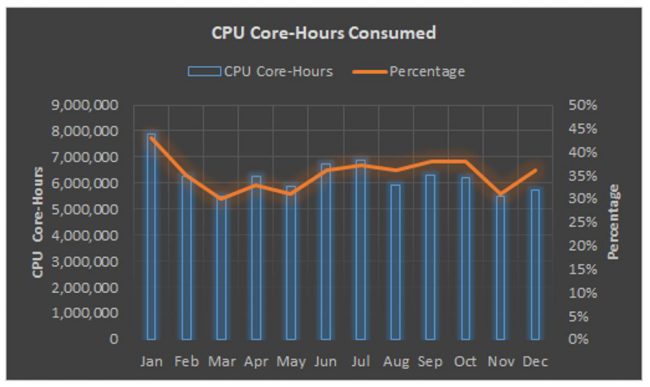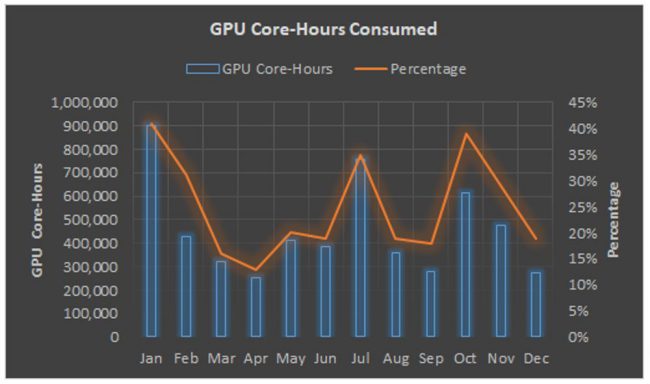OVERVIEW OF USING NSCC’S ASPIRE 1 SYSTEM BY NUS RESEARCHERS
The journey of the second year of service of the National Supercomputing Centre Singapore’s (NSCC) ASPIRE 1 ended inDecember 2017. As one of the three main stakeholders, more and more researchers from NUS started using the system for their large scale computational works and large data related computations.
In this article, the usage statistics of the ASPIRE 1 system by NUS researchers in year 2017 will be presented.
Trend of the number of users enrolled
NUS maintains its lead as the top institution amongst the three stakeholders – NUS, NUS and A*STAR in terms of the number of users enrolled in the ASPIRE 1 system. In 2017, the number of NUS users in the ASPIRE 1 system increased from 578 in January to 1190 in December. The monthly trend is found below:

Usage of CPU and GPU Computing Power
The ASPIRE 1 system consists of a high-performance computing (HPC) cluster with 1,128 dual-CPU compute nodes and a GPU-accelerated computing cluster with 128 GPU nodes installed with Tesla K40 GPUs.
The statistics of the HPC cluster usage by all the NUS users is illustrated by the CPU core-hours consumed at monthly basis, as shown in this plot. In general, NUS users consumed about 5.5 to 8 million CPU core-hours a month, which is approximately equal to running with 8,000~11,000 CPU cores continuously for 30 days. Compared with the overall usage, NUS users consumed about 30~45% of the HPC cluster computing resources.

The statistics of the GPU usage by all the NUS users is illustrated by the GPU core-hours consumed at monthly basis. From the usage status, it is observed that usage patterns fluctuate from 15% to 40% of the overall consumed GPU resources.

The Most Used Applications
The most used applications on the ASPIRE 1 system is tabulated below. Almost all the application tools are open-source packages or users’ in-house programs. Users running molecular dynamics and material science applications benefited the most, followed by the engineering-related simulation users and data analytics, including deep learning and machine learning.
| No. | Most Used Application | Domain |
|---|---|---|
| 1 | Amber | Molecular simulation |
| 2 | AutoDock | Automatic docking |
| 3 | BerkeleyGW | Material science |
| 4 | Gromacs | Molecular simulation |
| 5 | LAMMPS | Molecular dynamics |
| 6 | NAMD | Molecular dynamics |
| 7 | Nektar++ | Finite element analysis |
| 8 | OpenFOAM | Computational fluid dynamics |
| 9 | Python | Generic programming |
| 10 | Quantum Espresso | Molecular calculation & Material modelling |
| 11 | R | Data analytics |
| 12 | simflow | Computational fluid dynamics |
| 13 | VASP | Molecular dynamics |
| 14 | WRF | Weather research and forecasting |
Most Active Departments
The most active departments from NUS are identified by the most number of active users and the most active projects in the ASPIRE 1 system.
| No. | Most Active Departments |
|---|---|
| 1 | The Centre for Advanced 2D Materials |
| 2 | The Department of Civil & Environmental Engineering |
| 3 | The Department of Chemical and Biomolecular Engineering |
| 4 | The Department of Chemistry |
| 5 | The Cancer Science Institute of Singapore |
| 6 | The Department of Biological Sciences |
| 7 | The Duke-NUS |
| 8 | The Department of Mechanical Engineering |
| 9 | The Department of Physics |
| 10 | The Tropical Marine Science |
| 11 | The Temasek Laboratories |
About ASPIRE 1
ASPIRE 1 system provided by the NSCC is the national first ever 1 PFlops computer. Its three stakeholders are NUS, NTU and A*Star. NUS staff and students can enrol and use the ASPIRE 1 system using their NUS-ID and password at https://user.nscc.sg/saml/.

